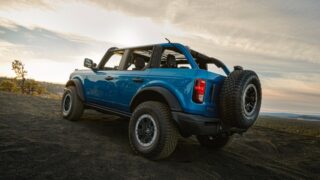|
By William Dahn
This article describes in detail the installation of a late model intermittent wipe wash system in a
61-66 Ford F100. The information provided here is applicable to other vehicles so feel free to
improvise and share your experience with this conversion in the Ford Truck Enthusiasts forums.
Follow these instructions using all Ford parts available in the junk yard or new parts available
at parts stores and your conversion will be undetectable to the casual observer. Well
functioning intermittent wipers really contribute to improved safety and driving comfort of these
old Fords. I am a certified Ford nut and passionate about this hobby. I hope that explains why
these instructions are overly detailed and too long! I enjoyed writing this article and sincerely
hope it helps you enjoy this hobby.
Parts list
Two speed wiper switch with push/wash and variable intermittent wipe selector
Variable governor control with wiring harness
Four wire electric motor with harness and connector
Wiper switch knob for 61-66 Fords with set screw mount
Wiper motor mounting bracket from 61-66 F100
Single speed wiper motor rotating arm (removed from your old motor)
Tube of automotive sealant (silicone)
Tube of electrical grease (dielectric)
Crimp connectors, ring connectors, 12 gage automotive wire
Washer motor and reservoir
Horn relay
Additional parts (may or may not be needed):
Wiper transmission arms
Flat washers for wiper transmission arms and motor attachment
Mount clips for transmission arms (3)
Wiper pivot assemblies and bezels
15 inch wiper blades
Tools list:
3/8th drive ratchet and a 1/2 and a 7/16 inch deep well sockets
1/2 inch drill motor
Drill bits
Felt tip marker (Sharpe)
Work bench with vise
PB Blaster
WD-40
Some wire
Alligator clips
Removing the 61-66 wiper motor
I am including this as a separate step because two of the three bolts holding the wiper motor bracket to the firewall have been exposed to the weather for 40 years and are probably rusted stuck. Soak the exposed ends of these bolts with PB Blaster by spraying through the cowl vent grill. Doing this several times for several days prior to removing the bolts will prevent ruining the blind fasteners mounted in the firewall. Use lots of patience along with plenty of PB Blaster and oil as you remove these bolts. If these bolts are sticky heat them with a torch. Getting out the top two bolts will be the most difficult part of this entire up grade. Remove the instrument cluster, radio, defroster tubes, old switch, wiper transmission arms and windshield wiper arms and blades. To remove the wiper switch knob, insert a tiny flat blade screw driver in the slot on the bottom of the knob and push up while gently pulling on the knob. It should come right off. If it is stuck, use a little PB Blaster. Save this knob as it also works for your heater control. To remove the bezel retaining nut use the correct spanner socket or a Phillips screw driver and work the nut loose carefully.
4 Wire Wiper Motor Mount Bracket
Having done many of these conversions I have noted that some early wiper brackets 61-64 may not have a brass ground strap between the mount bolt and the bracket. I use the brass ground strap removed from the late model wiper mount bracket salvaged from the Junk Yard. If you bought your motor and do not have a ground strap on your wiper motor bracket you will need to fabricate one. Remove the 4 wire motor from the later model wiper motor bracket. Drill out the retaining rivet and remove the brass ground strap from the bracket. Remove the washers, spacers and rubber grommets from the bracket. Make a note of how these small parts are installed and be careful you don’t ruin the rubber grommets. I hose the grommets with WD-40 so they squeeze out easier. Using the best grommets and cleaned washers, reassemble the 61-66 bracket. Place the brass ground strap over the lower motor mount hole on the left and push a mount bolt through it and the grommet to hold the strap in place. Mark the other end of the strap and drill a small hole in the 61-66 wiper bracket to rivet the strap in place. Use a steel pop rivet or screw to fasten the brass ground strap to the bracket. Install the 4 wire motor. Install the 61-66 rotating arm. Don’t over tighten these bolts. You should now have a 61-66 wiper motor bracket with 4 wire motor, good grommets and a brass ground strap all neat and ready to go back on your truck.
Installing the 61-66 Rotating Arm
Remove and toss the 4 wire motor rotating arm. Install the 61-66 rotating arm onto the shaft of the 4 wire motor and tighten it snugly. If you have a Bosch American two speed wiper motor, the rotating arm will not work for this conversion. You will need to find a standard single speed Motorcraft wiper motor and use that arm and bracket. If you have a Bosh American two speed motor, save it, the original bracket, harness and switch. These are rare and you would do well to sell it to a collector.
Modifying the Wiper Switch With Rheostat
Compare the new wiper switch with the old switch. Notice how the new switch has a longer knob shaft and more mounting threads than the old switch. Put the new switch in the vise and carefully shorten the knob shaft about one quarter of an inch (measure carefully using the old switch). File the end of the knob shaft smooth and using a flat file, extend the flat closer to the switch housing. Leave a little extra round length 1/8th inch between the flat and the switch housing because the new switch has provisions for a push/wash feature and you will need a bit of clearance between the bezel and end of the knob to work that feature. The round portion also acts as a stop for the knob if you push to vigorously. Install a knurled nut from the original switch (run it all the way on). Install the switch, wiper bezel, second knurled nut, and the knob for a trial fit. Run the inner knurled nut out until the bezel and outer knurled nut fit properly. Adjust the flat portion of the knob shaft with the file if the knob doesn’t go on the shaft far enough or cut off a bit more length. Leave some clearance between the end of the knob and the bezel so you can operate the push/wash feature.
Bench testing and parking the motor
On the bench! Install the new knob onto the modified switch. Just snug the retaining allen screw. Add some dielectric grease to the terminals and plug in the governor relay harness (red connector). Use more dielectric grease and plug in the connector and harness for the 4 wire motor. Connect the power lead from the 4 wire harness to a 12 volt source (battery on the bench). Ground the motor/switch/bracket and connect it to the negative terminal of the source. The motor should now operate with the switch. Test all locations on the switch and the relay. Let it run a few minutes, then turn off the switch. Don’t pull the wire off the 12v supply, because that will not park the rotating arm in the correct position. You must stop and park the motor using the switch.! The rotating arm should stop (park) pointing to the left side of the mount bracket, if it points to the right remove and flip it.
Final assembly
Run a 1/8th wide bead of silicone around the three bolt holes on the bracket. Put the bracket and motor aside for now. Install the wiper switch and connect the power lead to an ignition hot lug on the ignition switch. Connect the black ground wire to the ground point for the cluster (on the brake pedal support). The silicone on the bracket should be set by now so install the bracket and motor. Take your time on this, do not strip the bolt holes in the cowl. Connect the transmission arms and run the wiper motor for a couple of cycles. The motor, transmission arms, and wiper pivots should operate smoothly and quietly. The ends of the transmission arms may be bent slightly to allow free operation without binding. Sometimes swapping the position of the arms (end for end) on the motor arm will also help. I usually install the driver side first, then the passenger side. These arms should slide on easily without undue stress on the bushings (use moly grease). The black arm is shorter than the silver and it goes on the driver side. The retainer clips are tiny and easy to drop. Run a piece of thread around the clip and let it hang, this way when you drop the clip you’ll be able to find it, you will, and you have been told! Investigate and fix any unusual noises or squeaks. Install the wiper arms and blades (use moly). Wet down the windshield and check out your new technology!
Washer function details
I use a horn relay to provide power to the washer pump motor. This relieves the switch of any function other than providing the low amp ground circuit needed to close the relay circuit.
Bench testing the push/wash switch
Plug the wash harness connector into the switch. Connect the two leads to the washer motor you plan to use. Push the wiper switch, the wash motor should function and the wiper motor should operate two or three swipes and then park. It may not, some of the older setups require you to turn on the wiper function, push wash and then turn the wipers off. I am still working on this so if you figure it out e-mail me.
Where to look for parts
1990 Ford pickups have the governor and switch. Older trucks have them as well usually to 1984 or so. The right switch is big and has a black ground wire, none of the others have this ground wire. The governor has a red plug and is found on late 70’s through 1990’s. The four wire motors with the correct plug will be found on 76 through 79 F150 and F250s. The washer plug is usually found in the trucks with the four wire motor and it will work with the governor plug.
Read the other FTE tech article How to Install Interval Wipers on a 73-1979 F Series Truck by Thomas Hogan. Study the pictures.
|




